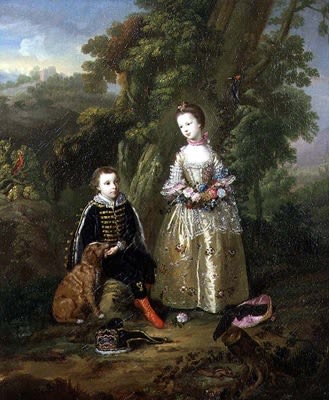
Thomas Frye
To view all current artworks for sale visit philipmould.com
This outstanding conversation piece is a collaborative work by Thomas Frye and Judith Lewis, two of the most original artists to have emerged from Ireland in the 18th-century. As such it an important part of the oeuvres of both artists.
One of the most influential and versatile artists of his generation, Thomas Frye was born near Dublin in 1710. Although little is known about his early life and training he appears to have gone to London in 1734 and two years later was commissioned to paint a portrait of Frederick, Prince of Wales for the Sadlers' Company.
In 1744 he was one of the founders of the Bow porcelain factory in east London, which was established to compete with the trade in imported porcelain from China and was the first factory of its kind in England. Frye's obituary, which was not published in the Gentleman's Magazine until 1764, two years after his death on 2 April 1762, refers to him as the Inventor and first Manufacturer of Porcelain in England and states that to perfect it he spent fifteen years among Furnaces. 2 Frye perfected the formula for porcelain using an admixture of bone ash and was also manager at Bow until 1759 when ill-health forced him to retire. His obituary records that his constitution was near destroyed through his intense application and labour amongst the noxious fumes of the factory.
Dr. Michael Wynne of the National Gallery of Ireland, Dublin has confirmed that the portraits and figures are by Thomas Frye and that the landscape is by Judith Lewis.
He continued to paint portraits during his period of managership at Bow, a period during which he was not only directly responsible for overseeing the manufacture of the porcelain but also probably for the design of many of the wares. 3 The re-emergence of this conversation piece reveals new critical evidence in the close parallels between the style, detail and decoration of the porcelain manufactured at Bow and Frye's own work as a portrait painter. 4 Dr Michael Wynne of the National Gallery of Ireland has already pointed out the similarities between a number of specific Bow pieces and these portraits, in particular the elaborate, theatrical women's head-dresses and coiffures found in Frye's portraits and Bow rococo porcelain sphinxes of c. 1750.5
Although the doll-like poses of Herbert Hickman-Windsor and his sister Charlotte are generally reminiscent of Bow porcelain figures, it is possible to find a near exact comparison. The pose of the young girl with her head tilted to one side is close repeated in the female figure from The Cooks of 1754-7, where she holds in front of her a leg of mutton instead of flowers. They also both have elaborate floral embroidery on their dresses.6
Furthermore, the overall atmosphere of arcadian exotica that is so prevalent in the painting is in keeping with the style of the oriental china which the Bow factory was consciously emulating. The exotic birds, dog and squirrel are all close to models in the Bow range. The exquisite rendering of colourful details such as the flowers, silks, satins and frothy lace mirrors much of the painted enamel work found on Bow plates and dishes of this date.
This is Frye's only known collaboration with Judith Lewis. Lewis, of whose work only three other signed examples are known, was the sister of Stephen Slaughter, the Dublin-based portrait-painter. She was one of the few accomplished female painters working in Ireland during the 18th-century and the wife of another Dublin artist, John Lewis (fl. 1739-69), who was the first scene-painter to be permanently engaged on the staff of a Dublin playhouse at the Smock Alley Theatre. 8
She seems to have absorbed continental influences, largely through Thomas Frye, her collaborator on this painting, as well as from her brother and husband. A pair of sporting conversations, signed and dated 1756, were sold at Christie's in 1960. After the death of her husband, she lived in Kensington with her brother Stephen Slaughter (1697-1765), Keeper of the King's Pictures from 1744, her married brother Edward, and her spinster sisters Catherine and Mary. Examples of her work appeared in a sale of Stephen Slaughter's household effects on 3-4 March 1764.
The Viscounts Windsor of Blackcastle were a cadet branch of the Hickman-Windsor Lords of Mountjoy, and derived their title from Thomas Hickman-Windsor, who was promoted Viscount Windsor in 1699 for his long services in Ireland. He served as Colonel of the Earl of Macclesfield's Horse in Ireland from 1701-1707 and 1711-12. He was succeeded by Herbert, his son, (1707-1758), who married. Alice (worth £60,000) heiress of Sir John Clavering, 3rd Bart. Their children are depicted in the present painting. The eldest daughter, Charlotte Jane (1746-1800) married John, 4th Marquis of Bute.